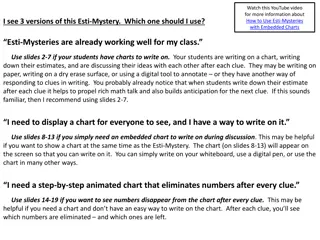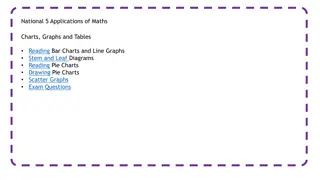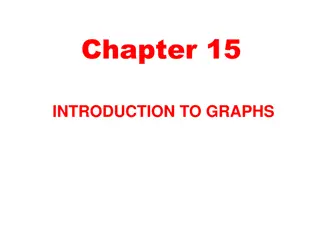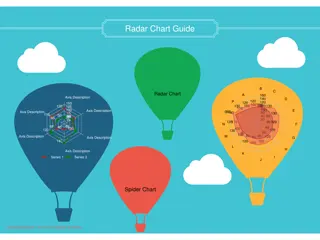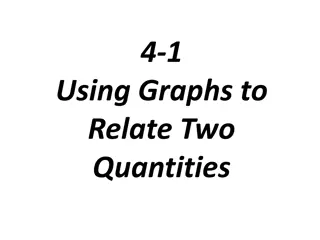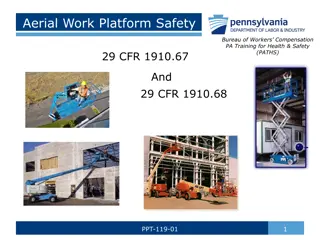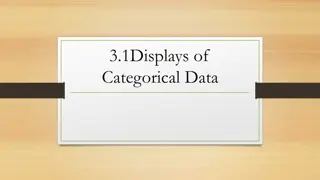Geographical Skills: Aerial Photographs, Charts, Graphs and Infographics
Aerial photographs are key tools for interpreting land surfaces, with vertical and oblique types used for different perspectives. Locating places on photographs involves dividing them into sections and understanding directions. Sketching aerial photographs requires creating a frame and dividing sections to accurately depict features. Charts, graphs, and infographics are also essential in geographical skills for visual representation and analysis of data.
Download Presentation

Please find below an Image/Link to download the presentation.
The content on the website is provided AS IS for your information and personal use only. It may not be sold, licensed, or shared on other websites without obtaining consent from the author.If you encounter any issues during the download, it is possible that the publisher has removed the file from their server.
You are allowed to download the files provided on this website for personal or commercial use, subject to the condition that they are used lawfully. All files are the property of their respective owners.
The content on the website is provided AS IS for your information and personal use only. It may not be sold, licensed, or shared on other websites without obtaining consent from the author.
E N D
Presentation Transcript
20 Geographical Skills Geographical Skills: Aerial Photographs, Charts, Graphs and Infographics 20
20 20.0 Geographical Skills Geographical Skills Learning Intentions You will be able to: Use and interpret information on aerial photographs. Draw sketch maps of aerial photographs. Compare OS maps with aerial photographs. Understand why charts, graphs and infographics are used and how to create them.
20 20.1 Aerial Photographs Geographical Skills Aerial photographs display the surface of the land. They are taken from the air and can be divided into two types: vertical and oblique. Oblique photographs Vertical photographs Taken with the camera looking down at an angle on the area being photographed Taken with the camera pointing straight down on the area being photographed
20 20.1 Aerial Photographs Geographical Skills Locating Places on Photographs North North North Top Left West Top Centre Top Right East To locate features on a vertical photograph, divide it into nine equal squares. Some vertical photographs will have a north arrow. West Middle East Middle Left Middle Centre Centre Middle Right N In such cases, use a compass direction when asked to identify the location of features. South South South Bottom Left West Bottom Centre Bottom Right East 1. Dividing up a vertical photograph 2. Vertical photo showing direction
20 20.1 Aerial Photographs Geographical Skills Locating Places on Photographs Left Centre Background Right To locate features on an oblique photograph, you must divide it into nine equal squares. Background Background The areas nearest the camera are called the foreground. Left Centre Right Middleground Middleground Middleground The areas furthest from the camera are called the background. Left Middle Foreground Right Foreground Foreground 3. Dividing up an oblique photograph
20 20.1 Aerial Photographs Geographical Skills How to Sketch an Aerial Photograph 1 Draw a four-sided border or frame for your sketch. This must be the same shape as the aerial photograph you are sketching. Unless instructed otherwise, make the frame half the scale of the original (half the length and half the width).
20 20.1 Aerial Photographs Geographical Skills How to Sketch an Aerial Photograph 2 Divide the photograph you are sketching into sections. Do likewise with your frame. These sections will help you better locate and sketch features of the aerial photograph correctly.
20 20.1 Aerial Photographs Geographical Skills How to Sketch an Aerial Photograph 3 Always draw important features such as coastline, skyline and horizon on your sketch map. This will also help you to better sketch features on the map in their correct location.
20 20.1 Aerial Photographs Geographical Skills How to Sketch an Aerial Photograph 4 Title your sketch map, e.g. Sketch of [Name of location] Aerial Photograph . Sketch of [Name of location] Aerial Photograph
20 20.1 Aerial Photographs Geographical Skills How to Sketch an Aerial Photograph 5 Coastline Tower Label all features you are asked to sketch in the question. Pier Long sandy beach Connecting street Church Two parallel streets Sketch of [Name of location] Aerial Photograph
20 20.2 Examining Aerial Photographs: Colour and Shape Geographical Skills The different colours on an aerial photograph can help you identify the possible uses of land and other features. Trees: Can be dark or light green depending on their type Rivers, lakes and seas: Will be different shades of blue or possibly silver depending on the light they reflect Roads: Will be light grey
20 20.2 Examining Aerial Photographs: Colour and Shape Geographical Skills The different colours on an aerial photograph can help you identify the possible uses of land and other features. Cereals(crops such as barley or wheat): Will appear yellow or golden in colour. Pastureland (grassland left for animals to graze): Will appear green or dark green.
20 20.2 Examining Aerial Photographs: Colour and Shape Geographical Skills Identifying Time of Year on Aerial Photographs Summertime Wintertime Trees: In wintertime, deciduous trees will be bare (Nov to Apr) Trees: In summertime, deciduous trees will be covered in leaves (May to Oct) Farm animals: Absent from the fields, as they are housed in sheds during cold winter months Farm animals: You may see farm animals grazing in the fields Cereal growth: You may see fields of ripe cereals (July to Sept) Freshly ploughed fields (Nov to Apr)
20 20.2 Examining Aerial Photographs: Colour and Shape Geographical Skills Rural Settlement and Land Use on Aerial Photographs Historical Settlement Burial sites: Defensive sites: Ringforts, castles and round towers. Graveyards, standing stones and dolmens
20 20.2 Examining Aerial Photographs: Colour and Shape Geographical Skills Rural Settlement and Land Use on Aerial Photographs Present-day Settlement Houses and villages are evidence of present-day settlement.
20 20.2 Examining Aerial Photographs: Colour and Shape Geographical Skills Rural Settlement and Land Use on Aerial Photographs Land Use Pastoral farming Look for animals grazing and green fields. Arable farming Look for brown fields that show ploughing has occurred. Tanned colours may show crop growth or newly cut crop. Woodland Look for large areas of deciduous and coniferous trees. Buildings Look for individual houses, housing estates, farm sheds, factories and industrial estates. Transport Roads and railway lines can be identified. Recreational Look for sports grounds, playgrounds and golf courses.
20 20.3 Urban Settlement: Towns and Cities on Aerial Photographs Geographical Skills Town Functions and Services Most towns have multi-functional purposes and offer several services to people. Functions Functions & Services Past/Historical functions Residential: houses, apartments Retail: shops Defensive: castles, towers, town walls Commercial: offices Commercial: old warehouses, canals or docks, town squares used for cattle fairs Industrial: factories, industrial estates Religious: churches Transport: roads, rail Recreational: parks Tourism: hotels, beaches Medical: hospitals Educational: schools
20 20.3 Urban Settlement: Towns and Cities on Aerial Photographs Geographical Skills Economic Activities on Aerial Photographs Most of the functions seen and services provided by an urban area are directly related to economic activities. Economic activities can be divided into three categories. Primary Economic Activities The extraction and use of natural resources from the land or sea. Look for fields, farm buildings, fishing boats, piers and quarries. Secondary Economic Activities Include factories or businesses that make things. Look for large buildings and industrial estates. Tertiary Economic Activities Provide useful services, e.g. transport, shopping, educational, religious, healthcare, recreational and tourism. Look for railway stations, shopping centres, office blocks, schools, colleges, hospitals, sports grounds, car parks, etc.
20 20.3 Urban Settlement: Towns and Cities on Aerial Photographs Geographical Skills Traffic Problems and Traffic Solutions on an Aerial Photograph Traffic Trouble Spots The Central Business District (CBD) of a town or city; the main shopping streets. Places where streets become narrow Places where streets converge (meet), e.g. near a bridge
20 20.3 Urban Settlement: Towns and Cities on Aerial Photographs Geographical Skills Traffic Problems and Traffic Solutions on an Aerial Photograph Traffic Solutions Traffic lanes: Using arrows or other markings Traffic lights: Placed at busy junctions Yellow boxes: Used to regulate the flow of traffic at junctions Roundabouts: Reduce potential delays where busy roads meet Parking restrictions: Single and double yellow lines along sides of streets to prevent or limit parking Off-road car parks: Multi-storey car parks placed off street to prevent car parking from cluttering a town Pedestrianised streets: For people and not vehicles By passes/Ring roads: Take traffic and Heavy Goods Vehicles around towns
20 20.3 Urban Settlement: Towns and Cities on Aerial Photographs Geographical Skills Urban planning is the process of designing and shaping urban areas, such as villages, towns and cities. Children s hospital site before building began Plans for the new children s hospital
20 20.3 Urban Settlement: Towns and Cities on Aerial Photographs Geographical Skills You can identify urban planning when you see evidence of: Traffic management Special zones for housing, business, shopping Streets meeting at right angles; they can form orderly grid- or square- like patterns Specially designated green areas, parks and sports fields Central areas such as town squares Trees, planted to offer greenery and shade
20 20.3 Urban Settlement: Towns and Cities on Aerial Photographs Geographical Skills Recreation and Tourism on Aerial Photographs You can identify recreation and tourism areas on aerial photographs when you see evidence of: Scenic areas such as oceans, rivers, lakes, sandy beaches, cliffs and other features that would attract people to a specific area Services such as hotels, campsites and car parks Shops and shopping centres Green areas such as parks and playing fields Historical attractions such as castles
20 20.4 Comparing OS Maps with Aerial Photographs Geographical Skills OS maps and aerial photographs each have unique ways to display the physical landscape. All OS maps are drawn to a single scale. Only vertical photographs are to scale. Maps use contour lines and spot heights to show areas of precise height. Photographs show features realistically. Maps use symbols. Maps indicate the type and importance of roads. Look at the map of Dangan, Co. Galway on page 281 of your textbook. Maps give the names of places. Compare it to the vertical aerial photograph.
20 20.5 Pie Charts Geographical Skills A pie chart is a type of chart that displays information using a circle divided into segments and is useful for showing how a total number is divided up. Advantages of pie charts Can display a lot of information in a visual way Easy to understand Useful for establishing the most common or popular option
20 20.6 Bar Charts Geographical Skills Bar charts display information using bars of different heights and are suitable for making comparisons.
20 20.7 Line Graphs Geographical Skills Line graphs are often used to display information in a visually appealing way. Unlike pie charts or bar charts, line graphs can track changes to information over periods of time The following table displays the information accurately:
20 20.8 Infographics Geographical Skills Infographics display a lot of information in a visually appealing and easy-to-understand way. How to create a good infographic Keep it simple. Keep it focused. Show things visually. Make it a manageable length and size. Check your facts and figures.
20 20.8 Infographics Geographical Skills Good vs Bad Infographics Examine both of these infographics. Which infographic is better at displaying its information? Why?
20 Geographical Skills Video: Mapping a Comeback The Old Fashioned Art of Cartography in the Age of GPS




